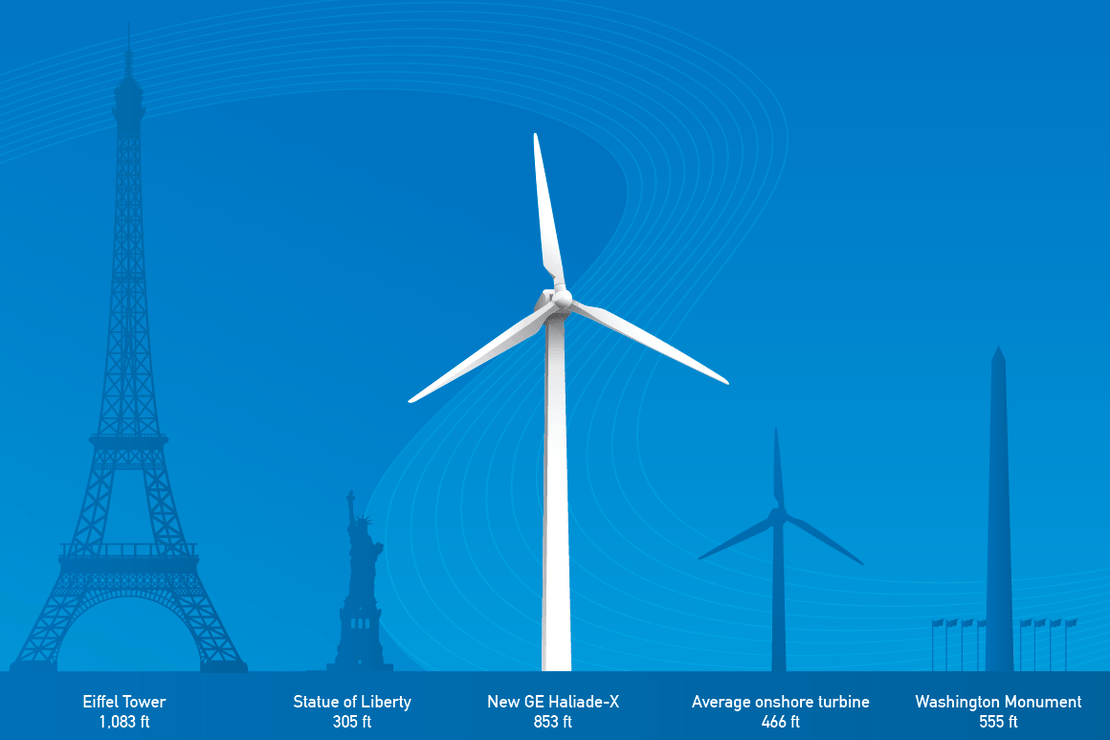Offshore wind turbines are growing larger. How big is too big?
By Heather Richards | 03/02/2023 07:09 AM EST
Claudine Hellmuth/POLITICO (graphic); iStock (images)
Even though offshore wind is just getting going in the United States, the turbines that will be used are changing dramatically — growing bigger and bigger.
Turbine towers as tall as skyscrapers make more electricity than their shorter predecessors. This will make offshore wind farms — a pricey form of green energy — cheaper for developers to build.
“There’s a big motivation to going bigger, because the more power you can capture with the single turbine, the more you can reduce cost of electricity,” explained Todd Griffith, an associate professor of mechanical engineering at the University of Texas, Dallas. “That’s been the single most important goal of the entire industry, to reduce costs.”Advertisement
But the race by global manufacturers to go enormous comes with its own significant hitch: It keeps changing the standard size of offshore wind turbines, potentially with ripple effects all the way down the supply chain.
“[The push for larger turbines] has a lot of ramifications throughout the industry,” said Sam Salustro, vice president of strategic communications at the Business Network for Offshore Wind, a trade organization that represents suppliers and manufacturers that serve offshore wind. “As long as you’re constantly changing design parameters and sizes, it’s much harder to really hit efficiencies of the entire supply chain.”
The size debate highlights the still-evolving nature of the young offshore sector in the United States and a potential complication for the Biden administration as it tries to lock in offshore wind to help decarbonize the grid by midcentury.
The trajectory of the turbine race could have serious implications for the White House’s wind goals, which include revitalizing ports and building a slew of manufacturing plants the White House hopes will create union jobs from the Carolinas to Maine.
Turbine towers made of steel, with blades the length of several school buses, will have to be designed, manufactured and put together. That includes the nacelles, rotors and foundations of the giant structures, not to mention the jack-up vessels needed to sink turbines into the seabed. Building a supply chain to reach President Joe Biden’s 2030 target of enough offshore wind to power 10 million homes represents $22 billion of investment, according to a recent Department of Energy report.
Industry observers say it could be difficult to reach that level of investment if goal posts keep moving. Others are concerned about the reliability of rapidly evolving turbines, as they are still untested in the real world.
For turbine design experts, like Griffith, the growing power of offshore wind turbines is exciting — pushing the boundaries of physics. But the speed is also concerning, with massive models entering the market quickly.
Griffith and others said the sheer size of these turbines isn’t currently a safety concern due to the rigorous testing ahead of putting new models on the market. While blades falling off turbines, towers crumpling or motors catching fire make headlines, engineers say these incidents represent just a small fraction of the thousands of turbines operating worldwide.
Still, only with research and time can the industry explore the “unknown unknowns” of massive turbines, Griffith said.
“It’s something we need to pay close attention to, to make sure that the reliability of these big machines remains as high as wind energy has been in the past,” he said.
Underwriting this rapid wind power evolution are a host of factors, including industry’s experience, technological improvements making offshore wind cheaper to develop and, most recently, climate policies.
The appetite for offshore wind is enormous, as many states and the federal government look for ways to power the electricity grid that does not involve burning coal, gas or oil.
Biden made a climate commitment to raising 30 gigawatts of offshore wind by 2030, with a moonshot of 110 GW by midcentury. The United Kingdom is aiming for 50 GW by the end of the decade, and the European Union and Asian regions like Taiwan and South Korea all have their own offshore wind goals.
These ambitions have created a heady atmosphere for the offshore wind industry globally, and wind farm developers have put increasing pressure on manufacturers to deliver more powerful models.
The results are feats of engineering almost hard to imagine, with towers standing taller than skyscrapers.
Seven years ago, five turbines standing 593 feet high were driven into the seafloor off the coast of Rhode Island, the country’s first offshore wind farm. They can generate 30 megawatts of power and are the primary energy source for Block Island’s roughly 1,000 year-round residents.
The next wind farm to be built — Vineyard Wind off the coast of Massachusetts this year — will use the General Electric Co. flagship Haliade-X series, which stands up to 853 feet tall. Each one will make twice as much power, together enough for roughly 400,000 homes.
But the towers are still growing. A Chinese turbine announced last month will have blades so long they scrape an area the size of 10 football fields when they spin. Its 18-MW max capacity is just short of the 20-MW threshold some in the industry are climbing toward.
Whether the standard holds at the current 13 to 15 MW that will be used in the first U.S. commercial-scale wind farms or jumps substantially, all of these new machines will need to be placed in the sea. From Asia to the Americas, the world does not have enough ships to install even the current large turbines. Developers have begun to fill this gap, one massive installation vessel at a time.
Dominion Energy Inc.’s $500 million Charybdis, for example, is the first U.S.-based offshore wind installation vessel. Still under construction, it’s already contracted to build the planned Revolution Wind and Sunrise Wind in New England. Speaking to the rapidly evolving turbine market, that ship can accommodate 12-MW turbines but has the flexibility to go larger, according to its developers.
But Salustro said that as turbine sizes keep shifting, it could give shipbuilders cold feet about investing in a vessel that turns out to be too small.
“It’s a tough choice for a vessel builder,” he said. “It’s much cheaper to build a vessel that only has to do 15 megawatts, but you are essentially expiring yourself on the day that your vessel is built, because all of a sudden, the market has decided that 20 megawatts is the size they are going for.”
The pace of growth may also undermine the tried-and-true testing of models in the field.
Sanjay Arwade, a professor in civil engineering at the University of Massachusetts, Amherst, compared the wind rush to consumer electronics, like cellphones. Generally, developers gradually improve products that are out for sale, with each new generation of a model adding updates or modest changes for the better. That helps manufacturers recoup their research and development costs in step with the release of new models. And it helps troubleshoot design weaknesses.
That well-trod process is not happening with these huge turbines.
“There’s concern amongst the OEMs, the turbine manufacturers, that the push to constantly go bigger and bigger and bigger is not going to give the industry an opportunity to learn from installed turbines,” Arwade said. “From their perspective, they would love to come out with a 15-megawatt turbine and sell it for 20 years.”
A spokesperson for General Electric said its strategy is to build on proven technology with each new model — the company has proposed two turbine manufacturing plants in New York if it captures enough offshore wind contracts there, which would make components for its next-generation Haliade-X turbine.
Development of the Haliade-X is already complicated, as a federal judge last year found GE had infringed on another company’s patent and barred GE from using the turbine in the U.S. market without changes. The company says its next-generation design would solve the patent infringement finding.
“At GE, we will continue to evolve our offshore wind turbine technology to meet our customers’ needs,” the company said in a statement. “We believe a key step in doing that economically is to take full advantage of existing platforms. With that in mind, the next generation model of the Haliade-X will build off the proven platform of its predecessor but contains some design changes and upgrades.”
Big as they are, the new offshore wind turbines are still short of what researchers have modeled as possible in the real world.
Griffith was on a team that designed a 50-MW turbine in 2017 with support from the Department of Energy. Its blades would be more than 800 feet long. The team explored the challenges with that scale, like the potential of increased bending of the blade under strain so that it could strike the tower during rotation. But it also found ways to counter structural problems, designing a segmented blade. It explored blades that can flip backward in high winds like palm tree fronds riding out the worst of a hurricane.
By the end of its research, Griffith said, the team found that the 50-MW turbine was feasible and would drive new and innovative research, such as using hinged flaps to manage the flow of air around the blade, like what’s visible on the back end of airplane wings.
John Hall, an assistant professor of mechanical and aerospace engineering at the State University of New York at Buffalo, said that whatever taps the brakes on building bigger turbines, it likely won’t be the limits of engineering.
“How big is too big?” he asked. “Literally, the sky may be the limit.”
